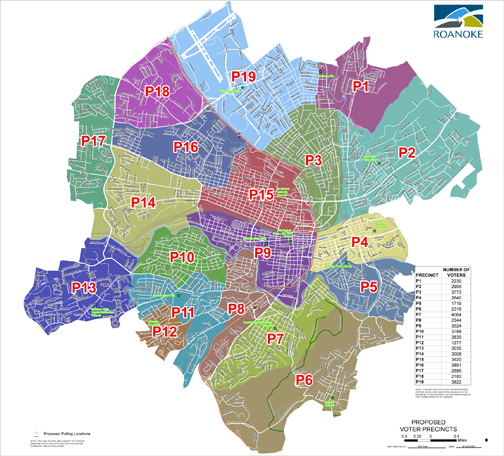
At William Fleming High School Tuesday about 10 people filtered in to review the proposed plan that would reduce the 32 precincts to 19. That was 10 more then showed up at Preston Park Recreation Center the night before – no one showed as staff and Electoral Board members waited for two hours. Only two people dropped by the Jackson Park Branch Library meeting said Chris Chittum, Planning Administrator.
The three Electoral Board members were there to talk to interested voters: Gordon Hancock, Rev. Carl Tinsley and Melvin Williams.
The 32 precincts “have been in place since 1967 as best as anyone can remember,” said Williams. The five precincts outside the 11th House of Delegates would remain in the 17th district to prevent voter confusion and split precincts. Those precincts include Monterey, Jefferson-Riverdale, Garden City, Lee-Hi and Grandin Court.
Some precincts like Preston Elementary School and Preston Park Recreation Center are across the street from each other. Other precincts have too few registered voters and there are a fixed number of voting machines that are spread too thin. In the precincts with too few registered voters machines sit idle.
A table full of laptops was manned by city staff who were prepared to answer any questions. GIS expert Kennie Harris was instrumental in assisting the Electoral Board’s efforts in presenting different scenarios. The maximum recommended registered voters in any precinct should be no more then 5000.
“The state board red flags when a precinct gets over 4000 registered voters,” said Williams.

Comments taken on a flip chart included concern that there were over 4000 voters in Precinct 7 in South Roanoke where the Crystal Spring Baptist Church was the voting location. Another citizen expressed concern over compressed precincts leading to long lines and discouraged voters. Another had concerns with limited number of voting machines to handle the increased volume.
The precinct plan took into consideration normal boundary landmarks – rivers and streams, railroad tracks and streets. Neighborhood organizations were taken into account in defining communities of interest. Some voters will have longer trips to their voting precincts while others will have shorter trips.
If approved the plan will reduce polling stations resulting in $10,000 of saving in personnel for each election. Hancock said that it has become increasingly difficult to get people to work the precincts. Each precinct requires a minimum of four precinct workers. As the older dedicated workers fall off the youth have not stepped in to fill the gap. “You just can’t find the people … It’s just going to get worse,” he said. The 16-hour day requires training.
Buildings are getting scarce as well according to Hancock – they just don’t want the hassle. They still haven’t found an ADA accessible building in the Wasena precinct. There is only one place that might pass but Hancock said it was still too steep a grade in his opinion.
The DOJ would scrutinize the location of the polling places, the number of voters in each precinct, the racial makeup and the distance from a polling station to each voter in a precinct. It must be no more then one mile. They also look at the type of polling places like schools and churches. It needs to be an open inviting locale for anyone with any background to come and vote.
The Electoral Board will report back to city council in September. Should council approve the proposal in December it must go to the DOJ by December 31, 2012. The first election with the compressed precincts would be the gubernatorial primary in the spring of 2013.
Registered voters will be notified of their polling places no less than 15 days prior to any election. Citizens can contact the Registrar’s office with comments at (540)853-2281, or visit the office at the Noel C. Taylor Municipal Building Room 109 or by email: [email protected].
